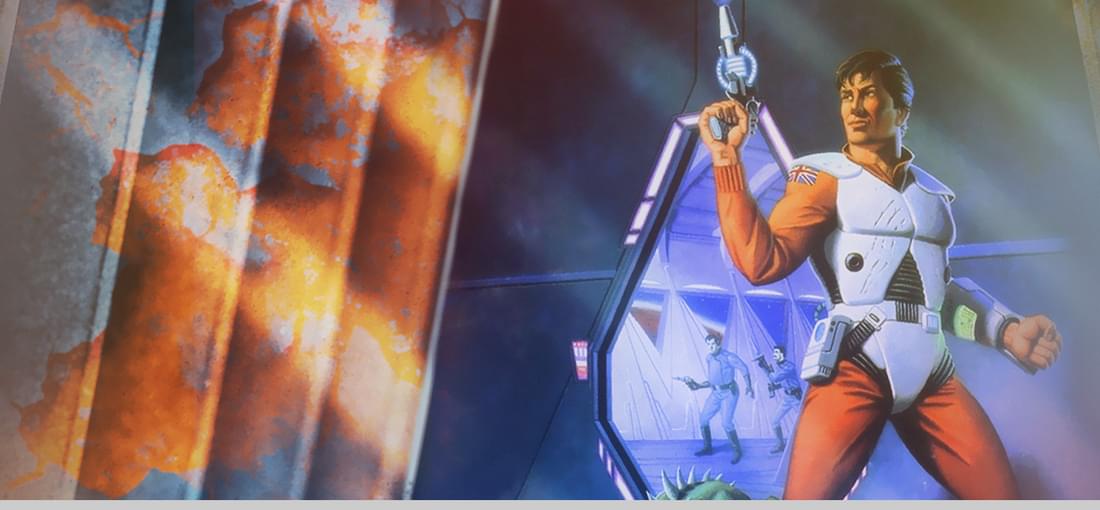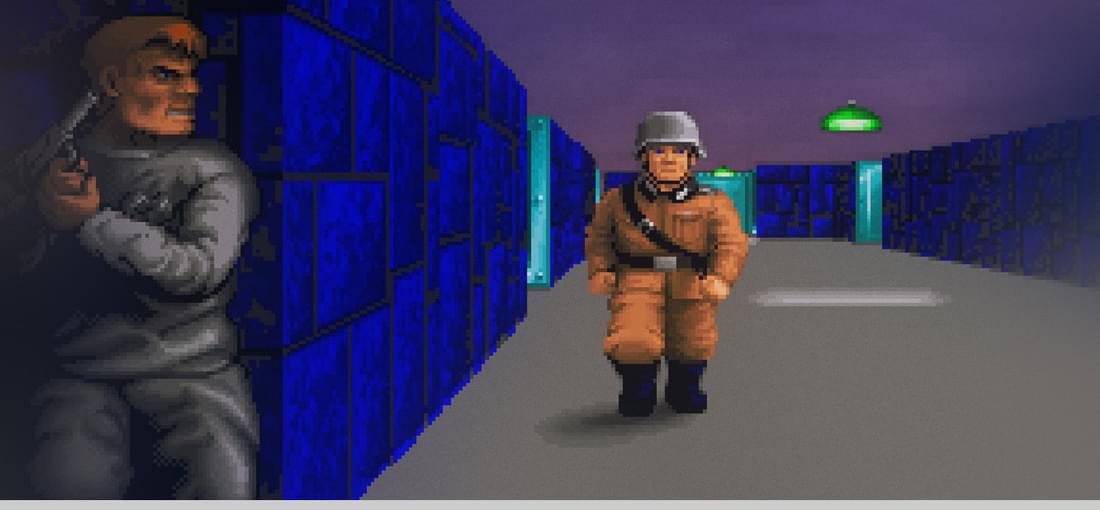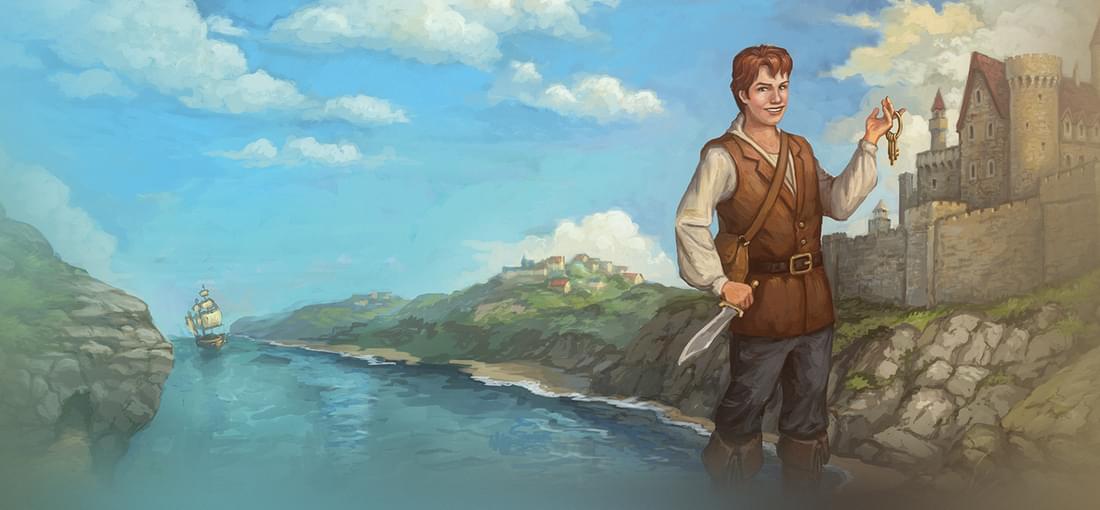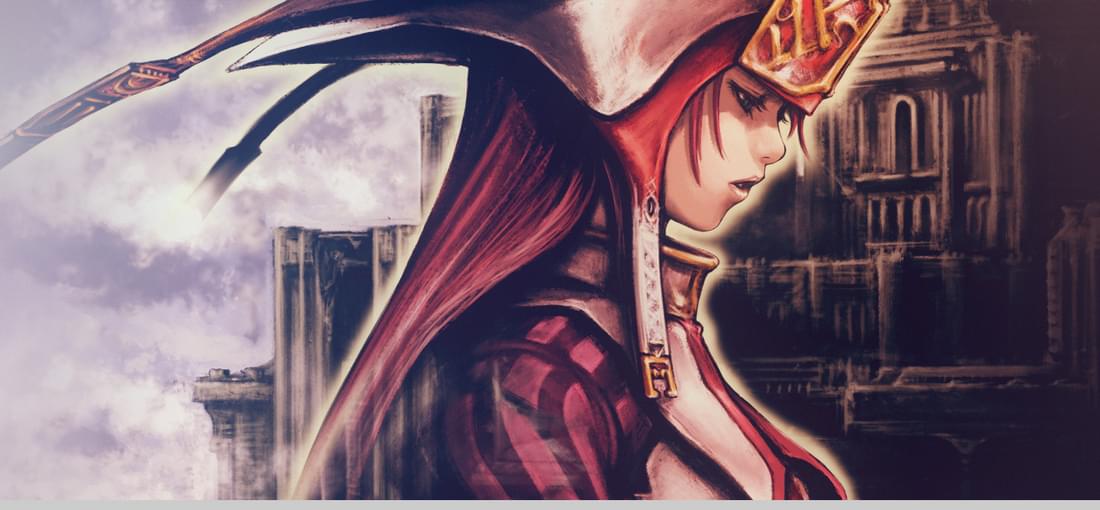


Score: 7/10 Pro: *Evolved Wolfenstein game engine allowed for texture mapped ceilings and floors and greater environmental interactivity. Instead of only picking up food from the ground, you can use vending machines to obtain life refilling “food like substances.” Your A.I. companion (Cortana?) provides mission data on the fly, such as the type of enemy you are engaging with and your current food token balance. Check what percentage of enemies or secrets remain on the current level whenever you like. *AUTO-MAP that fills in as you go! You can also revisit previously cleared levels to collect remaining ammo, food and treasure or find any missed secrets. *Environments are colorful and textures, although low res, are well drawn. A convincing vision of a living animated world. *The score by Bobby Prince of Wolfenstein and Doom fame. There is no denying the power of the bass line in this soundtrack. Funkified beats and some catchy tunes keep your toes tapping while you run face first through alien blood splatter and visceral gore. Con: *The energy plasma aliens. These guys regenerate rapidly and endlessly within rooms that have energy sockets. There is no way to turn off their spawning. Each one launches volleys of energy blasts at you, and one direct hit can almost completely drain your health. You will quickly be overwhelmed. Difficult to explore rooms where these guys roam. *Wow, this game is too long. 60 total levels, (54 if you don’t find the secret levels), with each one ranging between 15-30 minutes long. The game starts wearing thin around the 40 level mark. It took me 24 hours of play time to beat, which is really too much for a FPS built on the Wolfenstein engine. *The controls require a little tweaking to feel right. I recommend binding your "Interact" key to one near your arrows so that you can quickly open doors or test walls for secrets. As long as you have a large flat surface for mouse movement, you should do alright.

Pro: Revolutionary for time of release. First time we saw super fluid control in a 3D space from a first-person perspective. Id pioneered addictive gun play that felt satisfying. Doom would later provide a kinetic and visceral feel to firing weapons that was only achieved through an intentional design that married animation, sound and programming in perfect harmony. The designers successfully created a dynamic where you wanted to pull that trigger over and over and experience that ensuing cathartic wave of watching your enemies erupt into tiny bits, or “gibs” again and again. The seeds of that can be felt here with the rhythmic rat-a-tat-a-tat-a of the machine unloading into nazi soldiers. SOUND! Crisp and chunky sound effects. The clanking and locking of the metal doors sliding open and shut echoing around you. The crunchy reveal of a secret wall opening before you. Actual voices of the soldiers as they are alerted to your presence or cry out in their death throes. The sound design elevates the game to a higher level of immersion and fun. Superscaled and detailed sprites for the bosses. SPEAR OF DESTINY: The final level and boss. No spoilers here, but the twist at the end is great. It is the cherry on top of an overall incredible game experience and sets shooter fans up for the ballistic ride Id was about to take them on with their next big game! Con: The game is probably too long. 90 levels created at a time when the designers were limited in how much variety they could add to the design, causes it to feel like it stretches itself too thin and it becomes repetitive. 45-50 levels would have been ideal. Episode 4 Mission 7. Trigger the wrong secret panel, and you soft lock your game with no indication that you have done so, or how. In a game that encourages you to discover and explore every secret wall, this is particularly cruel and can result in hours wasted wandering the level in search of something missed. Something the game will never disclose. 7/10

One day, out of the blue, adventure games came gasping back to life. We had been told they were dead. Relegated to a distant, golden age of gaming that existed somewhere back before 1998. In those glimmering days of yore, the legends tell of master artisans who would weave their dreams into reality. Myth shapers. Storytellers and bards that could enchant, enthrall and captivate by the power of their ingenuity and imagination. Countless worlds were created for the intrepid adventurer to explore. Mysteries to be solved, secrets to be teased out, love to be won and yes... glory to be achieved (if you wanted to be a hero.) Standing tall amidst this pantheon of world-wrights were the Coles. Lori and Corey, in their Quest for Glory, contributed some of the most beloved adventures of the era. By infusing their own wonder, whimsy and nobility into their creations they won over the hearts of a generation of gamers. But alas, this golden age was not to endure forever. The darkness would come all too soon, obscuring the voices of these master storytellers. For long years, a generation of adventurers looked for the lost scribes, but they could not be found. Hoped beyond hope for their return, but it was not to be. And, as they searched... they grew up. Time stole each young dreamer away to tomorrow, until the memories of their high adventures were diminished to naught but a glowing ember tucked away somewhere in a secret portion of their hearts. There were those, of course, who held the torch aloft during those dark years. Stories of adventure were still crafted, and quality ones at that. But they were never heralded in the same fashion upon release and it seemed that the very soul of adventure had faded from its previous luster. Time passed, until one day, unexpectedly, a resurgence began. Heroes of that lost age began to emerge. They had new stories to tell! Lori and Corey were among them! The hearts of the adventurers began to sing. They clamored to support these legends in their endeavors and together, a synergy ensued that saw new adventures, new works of wonder, breathed into reality! 'Hero-U: Rogue to Redemption', by Lori and Corey Cole is one such result of that renaissance. After almost a six year wait, I settled myself down before the game, slightly nervous at what I might find. Six years of expectations rising and falling. Would this truly be a defining moment in the glorious return of the adventure game? Would it fall flat, or would it soar? Shakily, I started a new game. 36 hours of play time later, I believe I have discovered my answer. Hero-U is like your best friend from childhood. It's not the flashy prep or the muscular jock. It's not the popular girl that everyone wanted to date. It's not the edgy metal-head or wannabe gangster. It's the one who always stood by your side. The one you could trust with your secrets. Maybe not as glamorous or sophisticated as others. Maybe a little bit corny. But the one whose warmth you missed the most when they were away. The one you truly cared about, and who truly cared for you. This heart, this character is what I felt most strongly as I played through Hero-U. Each session of delving into the game felt like snuggling up to a good book in front of the fire. Each aspect of the game presented both highs and lows, but I will say this for certain, I never grew tired of playing. Despite its flaws, the game drew me in, enveloped me. I could not sense the time passing around me and I never wanted to stop. This is a testament to both the quality of the storytelling and the design of the impressively layered gameplay. The game excels in it's pacing, an art seemingly lost on many current games. The story unravels neatly, striking a balance between presenting mysteries and providing a sense of accomplishment for the player. The gameplay maintains a perfect balance of activities for the player to engage in, without becoming overwhelming. Within my 36 hours of gameplay there was always an objective, (and usually multiple objectives), that I was working toward. These objectives were always ones I genuinely cared about. I truly wanted to see the resolution of each new story element. The ticking 'real time' clock provided just the right amount of edge in order to inspire urgency without undue anxiety. Sometimes I would have to choose to perform certain actions and forego others in order to accomplish my priorities. This imitates real life in that we never have enough time to do everything we desire. Sometimes, what we give up helps us to appreciate what we chose to focus on all the more. One of the reasons all of this works is the sense that your decisions are making an actual difference in the way the story plays out. Your choices affect your relationships with the other students and the faculty at the University where the game takes place, and those relationships will either grant or restrict access to areas, story elements and side quests along the way. Corey Cole compared it to a river that is always in motion. You will never step in the same river twice. But it is more than that. A leaf upon the surface cannot stop the river from reaching its destination, but it may experience a different journey each time it travels on the water. As in life, the world does not stop turning simply because we choose to ignore it, but our choices dictate our involvement in that turning, for good or ill. By now you are likely realizing that the game harbors an impressive complexity hidden beneath the rather simplistic nature of its presentation. The art can be a mixed bag. At the outset, if I’m being honest, I found some of the character portraits to be rather unattractive. Additionally, the game uses still screens to signify important moments of story and character development or the passage of time, and many of these were somewhat awkward. However, there are exceptions and much of the art is actually impressive. The main dialogue portraits of Shawn, for example, are skillfully done and do a fine job at fleshing out his character and expressively portraying his emotions throughout the story. The environments are also impressive. It is obvious that a tremendous amount of love and attention went into every room and secret passageway in, around and under the castle where the game takes place. The university has a warm, lived in feel to it that exudes mystery and begs to have its secrets discovered. The sea caves were beautiful. Every time I journeyed there, I could almost smell the taint of the salt upon the air and a few times I swear I saw the walls shimmer with the reflection of the underground waterways. Overall the art was serviceable with a few low points and several moments of brilliance. The sound in the game was excellent. Sound effects were crisp and well executed. I loved the sounds of Shawn practicing his rope climbing, the grate of a secret passage sliding into place and the shuffling of cards at the gaming table. The music was also fairly impressive. The main theme catches you with intrigue and adventure right at the title screen and an effective refrain of that theme is used to emotional impact during poignant story moments throughout the game. Another highlight I have to mention is the excellent music that plays in the common areas during the nights of the dead. I lingered there for a bit just to hear it! My only complaint with the music is that I wish there was more of it. I feel like the intro scene with a camera that pans and zooms across a cityscape would have benefited from some musical accompaniment. As mentioned above, gameplay is addictive and enjoyable. Combat is rather simplistic but provides a generous amount of flexibility in how the player engages in it. Because of its turn based nature, a simple choice like whether to throw a trap, drink a healing potion or lay down a protective rune can mean the difference between life and death. The writing is witty and ladened with puns… and puns… and even more puns! It is a pun filled tour de force! (Or would that be a tour de farce?) Puns are the primary way the game rewards the player for interacting with otherwise mundane objects such as lamps, chairs and barrels etc. Some of them made me chuckle despite myself. Thank you for that Mr. Cole. The game is greater however, than the sum of its parts. In fact, I believe it’s primary attribute is not the art, the sound, or even the story. Rather, it is how the game works its way into your heart with its innocence and charm. There was a specific moment in my playthrough where I realized, the game had its hooks in me. I was hard pressed to finish exploring a specific dungeon within a short amount of time. Failure to do so and defeat the boss at the end would result in what I feared would be dire consequences to the way my story played out. Unfortunately, I was low on healing items and lyra (game currency). I was afraid I wasn’t going to make it. I decided my only choice was to pick the lock on the infirmary and raid a medicine cabinet for healing potions. In another game, performing this act would have been an afterthought. Just another action on the way to completing an objective. But even as I neared the door to begin the lockpick attempt, I found myself rationalizing the act. The infirmary was run by a character who had been nothing but loving and supportive throughout the story. I really wanted to be a hero. Is this something a hero would do? I reminded myself of the greater good and moved through the door. Again, as I neared the cabinet, doubts crept upon me. What if someone walked down the stairs while I was in the act? What would they think of me? Would the staff be disappointed? It did not occur to me that this was a game. But… but… there was a girl to impress… and time was short! No choice. I picked the lock on the cabinet and stole two healing potions. I was instantly overcome with regret. My conscience betrayed me. MY CONSCIENCE! I felt guilty. These characters, this environment had become real to me. I didn’t want to hurt people who had been my friends. I didn’t want to let them down. I paused there and tried to remember another game that had made me feel that way. I failed to do so. The game is filled with moments like this that build upon themselves and offer a tremendous amount of immersion. Now, at the end, I find myself filled with sorrow at having to say goodbye to these characters. I will miss sneaking through the passages of the castle, unravelling the secrets of the games lore, eating dinner and playing cards with companions and striving to win Esme’s heart. I will miss this game the way I miss the dear friends of my youth. The ones who always stood by my side. The ones I could trust with my secrets. Maybe not as glamorous or sophisticated as others. Maybe a little bit corny. But the ones I miss the most now that they are away. One day, out of the blue, adventure games came gasping back to life. I am glad I was here to see it!

My favorite game of all time is the NES classic Faxanadu (Title derived from "Famicom" and "Xanadu"). The sidescrolling RPG adventure which served as a side story to the game "Dragonslayer II: Xanadu" which was itself, incredibly popular in Japan, setting sales records for a PC game at the time. (400,000 copies sold.) Released in the U.S. in 1989, Faxanadu was a deep and atmospheric experience which wrapped players up in an unforgettable journey to the top of the World Tree on a quest to retrieve the fabled sword 'Dragonslayer' and destroy the 'Evil One' who was abusing the radiating power of a fallen star to corrupt the denizens of the great tree and turn them upon each other. The game left an indelible mark on me and I have always wanted to experience more games in the Dragonslayer and particularly, the Xanadu series. Unfortunately, despite boasting a library of 8 main installments and over 20 sequels and expansions, the majority of games in the Dragonslayer series have remained exclusive to Japan. So, I was stunned when I saw that Xanadu: Next had been released on GOG. I excitedly snatched it up immediately upon discovery and lost the next 4 days of my life. Not knowing what to expect, I went in with an open mind. The game was far different from my beloved Faxanadu, no longer a sidescrolling RPG akin to Zelda II, it had evolved into an isometric 3D dungeon crawler that was more evocative of Diablo, only with a Japanese flair. This was fine however as there were many themes that tied the game back to the world of Faxanadu (and based on my studies, to the greater Xanadu franchise) such as recurring items, magic, armor and Weapons, not the least of which is the legendary 'Dragonslayer' sword. Every level risen bestows a rank (ie. Fighter, Adept, Myrmidon, Hero etc.) and these ranks lined up exactly with the titles earned in Faxanadu. Playing through and discovering these little connections to my favorite game of all time added an additional element of enjoyment for me, but the game truly stands on it's own merits. Pros: Developing your character is an ultra addicting time sink. Combat is so much fun and deep customization options for your characters growth mean that you will not notice the hours flying by as you plumb the depths of ancient ruins, or scour the countryside in your quest to unravel an ancient mystery. When you gain levels you are granted points which can be distributed amongst several stats such as you see fit. These include Strength, Mind, Reflexes, Constitution etc. Weapons and armor require specific stats to be at certain levels in order for you to wield them, so you are constantly working toward your next objective. Every weapon has both a proficiency rating that grows as you use it from 0% - 200% (so they do more damage as you become more proficient) as well as a unique skill that can be equipped for special moves or passive bonuses. When your proficiency with a weapon reaches 100% you learn the skill and retain it's use even after equipping a different weapon. Guardians can be found throughout the game world and joined to the player for extra unique bonuses such as additional XP gain, boosted magic, more effective healing items etc. These guardian that is joined with you levels up as you fight and can be swapped out at any time for another. Between leveling to use more powerful weapons and armor, mastering weapon proficiencies, learning skills and magic spells and leveling up your guardians, character development is never ending, and thoroughly enjoyable. The game takes place over a variety of locales from dank, murky dungeons to snowcapped peaks and from lava filled tunnels to epic labyrinthine fortresses. I never tired of traversing the landscape and the environment never became dull or boring for me. The music is AMAZING! True to the spirit of the old school JRPG, I found myself humming along with the soundtrack at times. The Eaglet Mountain and Lakebed Ruins themes especially were heroically dramatic and the Town theme was serene and peaceful, reminding me a little of the score from Dark Cloud. The pacing of the games dungeons was pretty much perfect. You strike deep into the heart of each area, unlocking shortcuts back just when you need them to allow for a return trip to town, to restock, rest and save before plunging in again. The dungeon layouts were sensible and even the 'Maze' like areas encouraged exploration and were more fun then frustrating. Cons: The graphics are dated. The game engine just does not hold up well and looks like a high res version of something that could have been a 3D PS1 game. (Make sure you change resolution settings right out of the gates, as the game defaults to 640x480 although you have plenty of options to change them to. I played in 1024x768.) This wouldn't be so bad, but the game released in 2005, four years after the PS2 ushered the PS1 into the twilight. It may have something to do with the fact that the game originally released as a title for the ill fated Nokia N-Gage. There are a lot of little touches that enhance the atmosphere such as roots growing down into dungeons from above or reflections on watery surfaces but the 3D is very basic overall. If playing via a gamepad, the interface can be a little cumbersome when navigating menus. The interface is pretty great in combat as hot button assignments allow for quick healing, spell casting and skill usage, but when during inventory management and when using the shopping and leveling menus, I found myself switching between the gamepad and the mouse. Overall though, I found that neither of these two cons detracted from my overall enjoyment of the game or sense of sheer fun I had while playing it, therefore it retains a perfect score of 5 stars from me. After falling in love with Faxanadu and losing myself thoroughly to this game, I desperately hope that more games from the Dragonslayer and Xanadu series become available in the west. I now count myself a fan and will be eagerly waiting for when they do. When they 'Xana-du'! :)